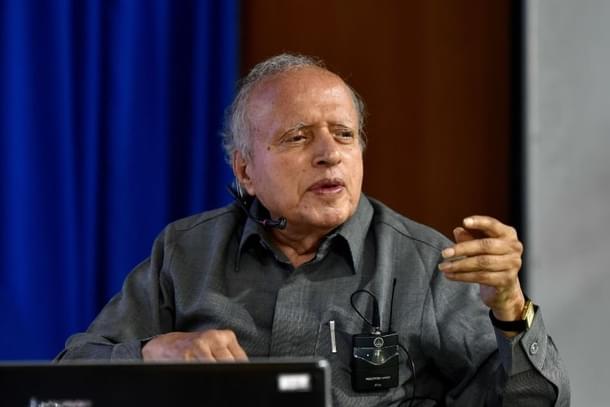Economy
Locust Attack: M S Swaminathan, Natural Farming Organisations Ask Government To Consider Non-Chemical Measures To Tackle The Menace
M R Subramani
Jun 17, 2020, 02:20 PM | Updated 02:20 PM IST
Save & read from anywhere!
Bookmark stories for easy access on any device or the Swarajya app.


Locust swarms have been spotted again in the country with several areas in Bhopal, capital of Madhya Pradesh, witnessing them yesterday (16 June).
The re-emergence of swarms and fears of locust attack continuing till July have led to demands for tackling the menace through non-chemical methods.
Times of India reported that the local administration sprayed pesticides to control the locusts in Bhopal yesterday.
The Food and Agriculture Organisation (FAO), an arm of the United Nations, said the locusts, which can change their behaviour and habits besides migrating over large distances, will “oscillate in North India before returning to Rajasthan in late June”.
It said swarms, which can vary from less than one square kilometre to several hundred kilometres, from the horn of Africa will arrive from early July onwards.
The locusts, which entered the country last month, attacked crops in Rajasthan, Gujarat, Madhya Pradesh, Haryana, Uttar Pradesh and Maharashtra.
The FAO has warned that “successive wave of spring-bred swarms from Iran and Pakistan will arrive in Rajasthan throughout June with additional swarming coming from East Africa to Gujarat and Rajasthan from early July onwards”.
The locusts, which can be anything between 40 million and 80 million in a sq/km, are expected to settle in cropping areas or head eastwards to Madhya Pradesh, Uttar Pradesh, Maharashtra, Chhattisgarh and, perhaps, as far as Bihar and Odisha.
According to FAO, the livelihood of at least 20 million people, most of them belonging to the vulnerable section, face threat due to locusts, the oldest migratory pest in the world.
These locusts can damage crop in over 25 million hectares of land and thus, throw the lives of the 20 million people out of gear.
The locusts can fly up to 150 km a day and if there is good rainfall and favourable ecological conditions, they can multiply 20-fold in a matter of 90 days.
In tackling the locusts, including helping neighbouring Pakistan, India has been using pesticides, which are basically chemicals. These pesticides are aerially sprayed using drones and helicopters.
The Centre has been urged to look out for non-chemical and friendly measures too.
Renowned agricultural scientist Dr M S Swaminathan tweeted that the best way to tackle locust invasion “is to spray neem seed decoction over plants”. Neem is a strong repellant and also a fertiliser.
The khudarati kheti abhiyan (Natural farming campaign) has called for tackling the locusts in a way that does not pollute air, water or the land.
Economic Times quoted organic farmer Chintala Venkata Reddy, a Padma Shri award winner, as saying that the government must adopt safer and non-chemical methods in areas close to water storage areas and catchment zones.
Reddy said that the locusts which do not travel during the night, could be caught and given to poultry birds as feed, adding that its feasibility has been established physically and economically.
Another method suggested in tackling the locusts is spraying a concoction of linseed oil, edible soda, extracts of garlic, cumin and orange.
The vegetation the locusts try to feed on can be rendered inedible by spraying a mixture of sub-soil. Traps or creating noises or placing traps at a considerable height can help trap or scatter the locusts and avoid damage to the crop.
The Ministry of Agriculture and Farmer Welfare has yet to respond to representations to consider non-chemical measures to tackle locusts.
Fears are that if the locusts get to have a free-run, they could affect the production of kharif paddy, which is currently being sown.
M.R. Subramani is Executive Editor, Swarajya. He tweets @mrsubramani





